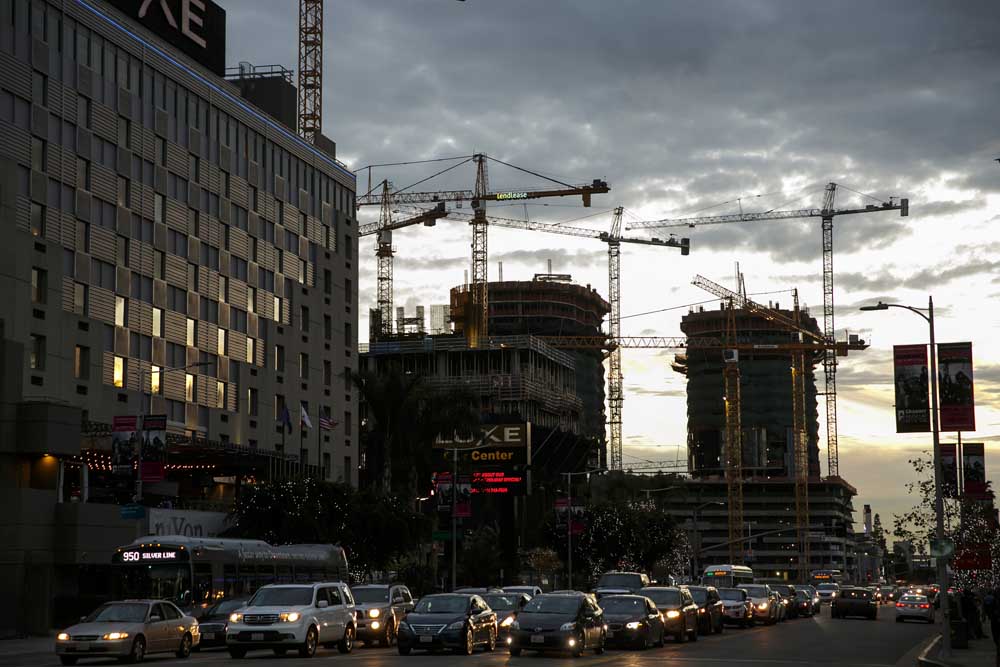Downtown L.A. sees historic building boom
Published 12:02 am Sunday, January 22, 2017

- Downtown Los Angeles is undergoing its largest construction boom in modern times, which is fueled by foreign investment that’s adding thousands of residences, construction jobs and a multitude of shops and restaurants.(Marcus Yam/Los Angeles Times)
LOS ANGELES — On the corner of Wilshire Boulevard and Figueroa Street in downtown Los Angeles, workers are putting the finishing touches on the Wilshire Grand, the West Coast’s tallest building. Owned by Korean Air, it rises 1,100 feet and will have a hotel, offices and observation deck when finished.
Two blocks away, China’s Greenland Group is busy building the four-tower Metropolis community, a $1 billion development with 350 hotel rooms and more than 1,500 condos.
Within walking distance are two other big projects that will add a combined five towers, 1,152 luxury residential units, 184 hotel rooms and 214,000 square feet of retail space.
Downtown Los Angeles is undergoing its largest construction boom in modern times — an explosion juiced by foreign investment that’s adding thousands of residences, construction jobs and a multitude of shops and restaurants.
Since 2010, according to real estate data firm CoStar, 42 developments of at least 50,000 square feet have been built — a figure that includes large adaptive reuse projects such as converting an aging warehouse into new offices. An additional 37 large projects are under construction.
The rapid pace means that by decade’s end, today’s boom should easily surpass the one in the 1980s — a time when developers built office skyscrapers on Bunker Hill as part of an urban renewal effort that flattened the neighborhood’s Victorian mansions in the decades before.
Sixty-four large developments were completed in that decade, remaking L.A.’s skyline in the process, before the boom collapsed in an early 1990s recession worsened by defense cutbacks after the Cold War.
The projects included the U.S. Bank Tower, which opened in 1989 as First Interstate World Center. It was the tallest building west of the Mississippi until being recently eclipsed by the spire of the Wilshire Grand Center, which is expected to open this year.
“What is happening now is amazing,” said Carol Schatz, president of the Downtown Center Business Improvement District.
To find a time when there was more construction, one would have to go back to the Roaring ’20s, when many of downtown’s most famous buildings were erected, including majestic movie palaces, the Biltmore Hotel and City Hall.
In all, 155 projects of at least 50,000 square feet were built from 1920 to 1929, according to CoStar.
That the ongoing construction wave is comparable to a time when downtown was the undisputed heart of a mushrooming metropolis is a striking example of the area’s transformation in the past two decades — from a sleepy, even dangerous, city center, into one filled with lofts, restaurants and art galleries.
The ongoing projects are putting thousands to work in a construction industry decimated when the housing bubble popped last decade.
Ron Miller, executive secretary of the Los Angeles/Orange Counties Building and Construction Trades Council, estimated that at just Metropolis and the Wilshire Grand there are roughly 2,800 union construction workers on the job.
“These are good middle-class jobs — averaging $60,000, $65,000 a year,” he said.
Today’s boom can be traced to 1999, downtown experts said. That’s when Staples Center opened and the city’s adaptive reuse ordinance took effect, making it easy for developers to redevelop old, vacant office buildings downtown into residences.
People moved into neighborhoods considered run-down, and bars and restaurants sprung up to serve those residents.
Last decade, 59 large projects were finished, and developers drew up plans for even grander buildings.
Though the 2007-09 recession sidelined those and threatened to stall downtown’s revitalization, new residents kept moving in, partly attracted by cheap rentals that developers had intended to sell as condos.
And when the economy began to recover, downtown, like other city centers across the nation, stood ready to benefit from an accelerating trend toward urban living among young professionals.
“Investors and developers said, ‘Hey, this is a big city and there is not a lot of new product here and it seems there is a little niche and a real opportunity to fill that,’” said Chris Casey, managing director of capital markets for JLL.
That’s the opportunity Carmel Partners saw.
In 2012, the San Francisco company purchased a development site at Eighth Street and Grand Avenue, believing that downtown was at a “tipping point” and “making that turn to officially becoming a 24/7 destination,” said Carmel managing partner Dan Garibaldi.
In late 2015, the firm opened Eighth & Grand, a 700-unit apartment building with a Whole Foods on the bottom floor where a studio starts at $2,300.
Others want to get in on the action, too. In all, more than 7,000 rental units are under construction, according to real estate firm Transwestern.
However, the upcoming flood of apartments and other developments is increasingly raising questions about how long the current boom can last.
Landlords of new apartment buildings are now offering incentives to sign a lease.
As a result, lenders and investors are growing more cautious on projects they will fund — a pullback in other marquee markets across the nation, including New York City and San Francisco.
“I think everyone is more selective,” said Casey of JLL, noting that investors are waiting to see how well the new projects lease up.
Garibaldi of Carmel Partners described the upcoming flood of projects as a temporary drag on rental growth that will shake itself out.
He noted that the company isn’t pulling back from downtown. It’s nearing completion on a 33-story apartment tower and is looking for more development sites nearby.
“We are firm believers in downtown — now, more than ever,” Garibaldi said.






